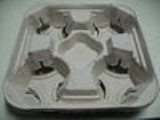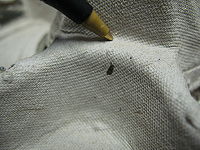
Molded pulp
Encyclopedia
Molded pulp, also named Moulded pulp or Molded Fibre, is a packaging material, typically made from recycled paperboard
and/or newsprint
. It is used for protective packaging or for food service trays and beverage carriers. Other typical uses are end caps, tray
s, plates, bowls and clamshell
containers.
For many applications, molded pulp is less expensive than expanded polystyrene (EPS), vacuumed formed PET
and PVC
, corrugation and foams.
Molded pulp is often considered a sustainable packaging
material, as defined by the Sustainable Packaging Coalition, since it is produced from recycled materials, and can be recycled again after its useful life-cycle.
trays etc.
Transfer molded products are usually thin walled, 1/16" to 3/16", and are the most prevalent type in use today. The process uses vacuum forming and take-off or transfer molds, where the mold is an extremely fine wire mesh in the shape of the upper/exposed surface. The fibrous slurries are frequently made up of a high percentage or entirely of recycled newspaper, which produces a relatively smooth surface on one side and a fairly smooth surface on the opposite side with good accuracy and definition.
Prior to the molding process, the mesh is mated with a vacuum chamber that draws water through the mesh into the chamber, with the mesh mold suspended above a liquid return pool. The fibrous slurry is sprayed from below onto the mold, and the vacuum draws the slurry tightly against the mesh, filling all gaps and spaces. When airflow through the mesh has been sufficiently blocked, the excess slurry falls into the return pool for recycling, and the mold advances onward to the drying process, following by separation of the mesh mold from the dried fiber plating.
Typical uses of transfer molded products are for packaging electronic equipment, cellular phones and other household and hardware items. Very high capacity, high-speed transfer molding equipment is used to produce drink trays, cup carriers ,wine shippers, egg carton
s, egg trays, pulp bedpan
liners, pulp urinals, fruit trays, slipper pans, commode pans, end caps, etc.
Paperboard
Paperboard is a thick paper based material. While there is no rigid differentiation between paper and paperboard, paperboard is generally thicker than paper. According to ISO standards, paperboard is a paper with a basis weight above 224 g/m2, but there are exceptions. Paperboard can be single...
and/or newsprint
Newsprint
Newsprint is a low-cost, non-archival paper most commonly used to print newspapers, and other publications and advertising material. It usually has an off-white cast and distinctive feel. It is designed for use in printing presses that employ a long web of paper rather than individual sheets of...
. It is used for protective packaging or for food service trays and beverage carriers. Other typical uses are end caps, tray
Tray
A tray is a shallow platform designed for carrying things. It is larger than a salver, a diminutive version commonly used for lighter and smaller servings, and it can be fashioned from numerous materials, including silver, brass, sheet iron, wood, melamine, and papier-mâché...
s, plates, bowls and clamshell
Clamshell
The flip or clamshell is an electronics form factor which is in two or more sections that fold via a hinge. If the hinge is on a long edge the device is more likely to be called clamshell than flip phone ....
containers.
For many applications, molded pulp is less expensive than expanded polystyrene (EPS), vacuumed formed PET
Polyethylene terephthalate
Polyethylene terephthalate , commonly abbreviated PET, PETE, or the obsolete PETP or PET-P, is a thermoplastic polymer resin of the polyester family and is used in synthetic fibers; beverage, food and other liquid containers; thermoforming applications; and engineering resins often in combination...
and PVC
PVC
Polyvinyl chloride is a plastic.PVC may also refer to:*Param Vir Chakra, India's highest military honor*Peripheral venous catheter, a small, flexible tube placed into a peripheral vein in order to administer medication or fluids...
, corrugation and foams.
Molded pulp is often considered a sustainable packaging
Sustainable packaging
Sustainable packaging is the development and use of packaging which results in improved sustainability. At the end stage of design it involves increased use of life cycle inventory and life cycle assessment to help guide the use of packaging which reduces the environmental impact and ecological...
material, as defined by the Sustainable Packaging Coalition, since it is produced from recycled materials, and can be recycled again after its useful life-cycle.
Type-1: Thick-Wall
These products usually have wall thicknesses of 3/16" to 1/2" and are used primarily for support packaging applications. Thick Wall is also commonly referred to as Slush Molded. The surfaces are very rough on one side and moderately smooth on the opposite side. Product definition is moderate due to the use of relatively inexpensive single-pass molds and the use of mixed recovered paper and kraft paper slurries. Typical uses are for edge and edge protector, heavy item packaging, auto replacement parts, molded pulp palletPallet
A pallet , sometimes called a skid, is a flat transport structure that supports goods in a stable fashion while being lifted by a forklift, pallet jack, front loader or other jacking device. A pallet is the structural foundation of a unit load which allows handling and storage efficiencies...
trays etc.
Type-2: Transfer Molded
 |
 |
 |
|
 |
|
| A McDonald's McDonald's McDonald's Corporation is the world's largest chain of hamburger fast food restaurants, serving around 64 million customers daily in 119 countries. Headquartered in the United States, the company began in 1940 as a barbecue restaurant operated by the eponymous Richard and Maurice McDonald; in 1948... spray-molded vacuum-formed cup carrier. The open slits are punched out of the carrier following the drying process. |
|
Transfer molded products are usually thin walled, 1/16" to 3/16", and are the most prevalent type in use today. The process uses vacuum forming and take-off or transfer molds, where the mold is an extremely fine wire mesh in the shape of the upper/exposed surface. The fibrous slurries are frequently made up of a high percentage or entirely of recycled newspaper, which produces a relatively smooth surface on one side and a fairly smooth surface on the opposite side with good accuracy and definition.
Prior to the molding process, the mesh is mated with a vacuum chamber that draws water through the mesh into the chamber, with the mesh mold suspended above a liquid return pool. The fibrous slurry is sprayed from below onto the mold, and the vacuum draws the slurry tightly against the mesh, filling all gaps and spaces. When airflow through the mesh has been sufficiently blocked, the excess slurry falls into the return pool for recycling, and the mold advances onward to the drying process, following by separation of the mesh mold from the dried fiber plating.
Typical uses of transfer molded products are for packaging electronic equipment, cellular phones and other household and hardware items. Very high capacity, high-speed transfer molding equipment is used to produce drink trays, cup carriers ,wine shippers, egg carton
Egg carton
An egg carton is a carton designed for carrying and transporting whole eggs. These cartons have a dimpled form in which each dimple accommodates an individual egg and isolates that egg from eggs in adjacent dimples...
s, egg trays, pulp bedpan
Bedpan
A bedpan or bed pan is an object used for the toileting of a bedridden patient in a health care facility, usually made of a metal, glass, or plastic receptacle. A bed pan can be used for both urinary and fecal discharge. Many diseases can confine a patient to bed, necessitating the use of bedpans,...
liners, pulp urinals, fruit trays, slipper pans, commode pans, end caps, etc.
Type-3: Thermoformed Fiber
This newest form of molded pulp is the highest quality of thin walled products available today. The process uses "Cure-In-The-Mold" technology which produces well defined, smooth surfaced molded pulp products. After being formed, the product is captured in heated forming molds which presses and densifies the molded products. They are accurately formed and have the appearance of plastic material. The products are ejected from the heated molds in their finished state as opposed to being dried in a heated oven. Typical uses for this type are for point-of- purchase packaging and those applications where high definition and appearance are of prime importance.Type-4: Processed
This type of molded pulp product is that which has undergone some kind of secondary processing which is generally different than or in addition to, the basic production procedure. This could apply to any of the first three types. Secondary processing could be coating, printing, hot-pressing, die-cutting, trimming or manufactured using colors or special slurry additives. Uses are for many kinds of custom applications.Further reading
- Brody, A. L., and Marsh, K, S., "Encyclopedia of Packaging Technology", John Wiley & Sons, 1997, ISBN 0-471-06397-5

